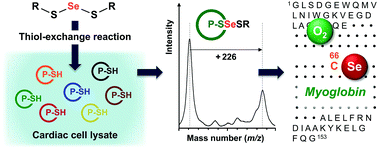当前位置:
X-MOL 学术
›
Metallomics
›
论文详情
Our official English website, www.x-mol.net, welcomes your
feedback! (Note: you will need to create a separate account there.)
Cardiac myoglobin participates in the metabolic pathway of selenium in rats†
Metallomics ( IF 2.9 ) Pub Date : 2018-03-09 00:00:00 , DOI: 10.1039/c8mt00011e Eriko Hori 1, 2, 3, 4 , Sakura Yoshida 1, 2, 3, 4 , Takeshi Fuchigami 1, 2, 3, 4 , Mamoru Haratake 4, 5, 6, 7 , Morio Nakayama 1, 2, 3, 4
Metallomics ( IF 2.9 ) Pub Date : 2018-03-09 00:00:00 , DOI: 10.1039/c8mt00011e Eriko Hori 1, 2, 3, 4 , Sakura Yoshida 1, 2, 3, 4 , Takeshi Fuchigami 1, 2, 3, 4 , Mamoru Haratake 4, 5, 6, 7 , Morio Nakayama 1, 2, 3, 4
Affiliation

|
As an essential micronutrient, selenium deficiency is a leading cause of cardiovascular diseases. The heart is continuously beating to deliver blood to the entire body, and this requires a high amount of energy. An adult heart normally obtains 50–70% of its adenosine 5′-triphosphate from fatty acid β-oxidation. An increase in fatty acid oxidation activity induces the generation of larger amounts of by-products (reactive oxygen species, ROS) from mitochondrial oxidative phosphorylation. Selenium-dependent glutathione peroxidases play a critical role in the removal of these ROS, especially organic hydroperoxides, from the heart. The definitive transport and/or detailed metabolic pathways from the selenium-source compounds to the selenoproteins in the heart still remain unclear. We explored the selenium-binding proteins in a rat cardiac cell lysate using its reactive metabolic intermediate, selenotrisulfide (STS), and MALDI TOF-mass spectrometry. Several proteins with a free cysteine (Cys) thiol were found to be reactive with STS through a thiol-exchange reaction. The most distinctive Cys-containing protein in the cardiac cell lysate was identified as myoglobin (Mb) from a rat protein database search and tryptic fragmentation experiments. When separately examined in selenium adequate rats, selenium-binding to the cardiac Mb was verified using selenium-specific fluorometry. Cardiac Mb is thought to participate in the selenium metabolic pathway in the heart.
中文翻译:

心肌肌红蛋白参与大鼠硒的代谢途径†
硒缺乏症是人体必需的微量营养素,是导致心血管疾病的主要原因。心脏不断跳动,将血液输送到整个身体,这需要大量的能量。成年心脏通常通过脂肪酸β-氧化获得50-70%的5'-三磷酸腺苷。脂肪酸氧化活性的增加诱导了线粒体氧化磷酸化产生大量的副产物(活性氧,ROS)。硒依赖性谷胱甘肽过氧化物酶在从心脏清除这些ROS(尤其是有机氢过氧化物)中起关键作用。从硒源化合物到心脏中硒蛋白的确定的运输和/或详细的代谢途径仍然不清楚。我们使用其反应性代谢中间体,硒代壬硫醚(STS)和MALDI TOF-质谱法研究了大鼠心脏细胞裂解物中的硒结合蛋白。发现具有游离半胱氨酸(Cys)巯基的几种蛋白质可通过巯基交换反应与STS发生反应。从大鼠蛋白质数据库搜索和胰蛋白酶裂解实验中,心肌细胞裂解物中最独特的含Cys的蛋白质被鉴定为肌红蛋白(Mb)。当在硒充足的大鼠中单独检查时,使用硒特异性荧光法验证了硒与心脏Mb的结合。人们认为心脏Mb参与心脏中的硒代谢途径。发现具有游离半胱氨酸(Cys)巯基的几种蛋白质可通过巯基交换反应与STS反应。从大鼠蛋白质数据库搜索和胰蛋白酶裂解实验中,心肌细胞裂解物中最独特的含Cys的蛋白质被鉴定为肌红蛋白(Mb)。当在硒充足的大鼠中单独检查时,使用硒特异性荧光法验证了硒与心脏Mb的结合。人们认为心脏Mb参与心脏中的硒代谢途径。发现具有游离半胱氨酸(Cys)巯基的几种蛋白质可通过巯基交换反应与STS反应。从大鼠蛋白质数据库搜索和胰蛋白酶裂解实验中,心肌细胞裂解物中最独特的含Cys的蛋白质被鉴定为肌红蛋白(Mb)。当在硒充足的大鼠中单独检查时,使用硒特异性荧光法验证了硒与心脏Mb的结合。人们认为心脏Mb参与心脏中的硒代谢途径。使用硒特异性荧光法验证了硒与心脏Mb的结合。人们认为心脏Mb参与心脏中的硒代谢途径。使用硒特异性荧光法验证了硒与心脏Mb的结合。人们认为心脏Mb参与心脏中的硒代谢途径。
更新日期:2018-03-09
中文翻译:

心肌肌红蛋白参与大鼠硒的代谢途径†
硒缺乏症是人体必需的微量营养素,是导致心血管疾病的主要原因。心脏不断跳动,将血液输送到整个身体,这需要大量的能量。成年心脏通常通过脂肪酸β-氧化获得50-70%的5'-三磷酸腺苷。脂肪酸氧化活性的增加诱导了线粒体氧化磷酸化产生大量的副产物(活性氧,ROS)。硒依赖性谷胱甘肽过氧化物酶在从心脏清除这些ROS(尤其是有机氢过氧化物)中起关键作用。从硒源化合物到心脏中硒蛋白的确定的运输和/或详细的代谢途径仍然不清楚。我们使用其反应性代谢中间体,硒代壬硫醚(STS)和MALDI TOF-质谱法研究了大鼠心脏细胞裂解物中的硒结合蛋白。发现具有游离半胱氨酸(Cys)巯基的几种蛋白质可通过巯基交换反应与STS发生反应。从大鼠蛋白质数据库搜索和胰蛋白酶裂解实验中,心肌细胞裂解物中最独特的含Cys的蛋白质被鉴定为肌红蛋白(Mb)。当在硒充足的大鼠中单独检查时,使用硒特异性荧光法验证了硒与心脏Mb的结合。人们认为心脏Mb参与心脏中的硒代谢途径。发现具有游离半胱氨酸(Cys)巯基的几种蛋白质可通过巯基交换反应与STS反应。从大鼠蛋白质数据库搜索和胰蛋白酶裂解实验中,心肌细胞裂解物中最独特的含Cys的蛋白质被鉴定为肌红蛋白(Mb)。当在硒充足的大鼠中单独检查时,使用硒特异性荧光法验证了硒与心脏Mb的结合。人们认为心脏Mb参与心脏中的硒代谢途径。发现具有游离半胱氨酸(Cys)巯基的几种蛋白质可通过巯基交换反应与STS反应。从大鼠蛋白质数据库搜索和胰蛋白酶裂解实验中,心肌细胞裂解物中最独特的含Cys的蛋白质被鉴定为肌红蛋白(Mb)。当在硒充足的大鼠中单独检查时,使用硒特异性荧光法验证了硒与心脏Mb的结合。人们认为心脏Mb参与心脏中的硒代谢途径。使用硒特异性荧光法验证了硒与心脏Mb的结合。人们认为心脏Mb参与心脏中的硒代谢途径。使用硒特异性荧光法验证了硒与心脏Mb的结合。人们认为心脏Mb参与心脏中的硒代谢途径。











































 京公网安备 11010802027423号
京公网安备 11010802027423号